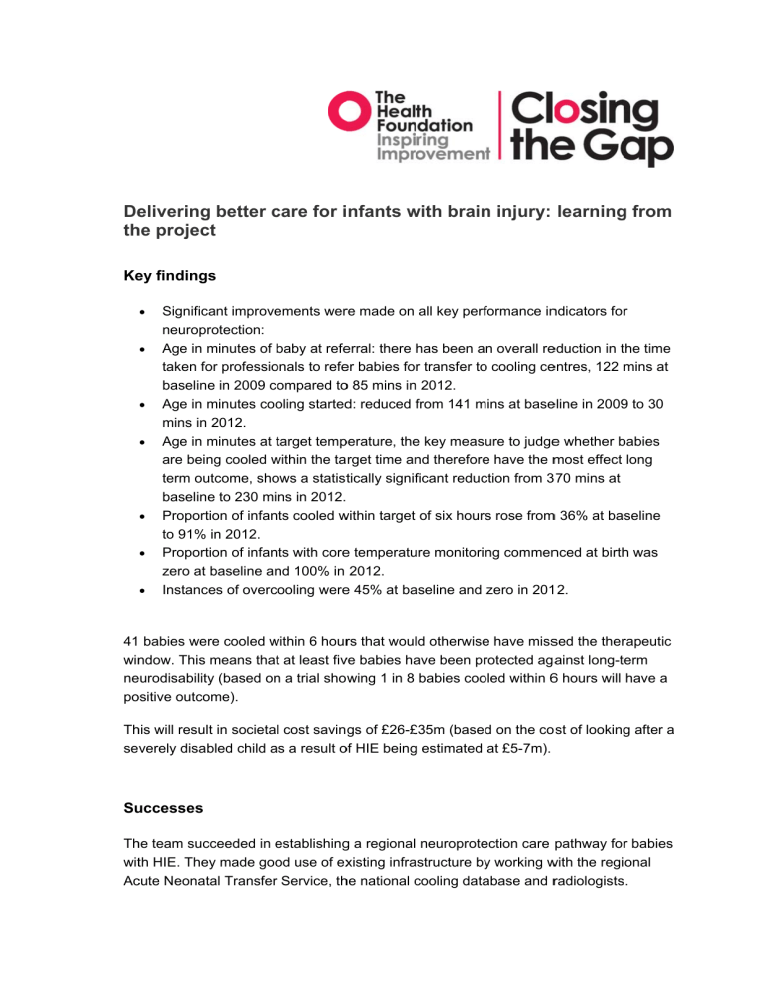De th elivering he projec g better c ct care for i nfants w with brain n
advertisement

De elivering g better care c for infants with w brain n injury: learning g from th he projec ct Ke ey findings Significant improve ements werre made on all key perfformance inndicators for neuroprrotection: Age in minutes m of baby b at refe erral: there has been an overall reeduction in the t time taken fo or professio onals to refe er babies for transfer to o cooling ceentres, 122 mins at baseline e in 2009 co ompared to o 85 mins in n 2012. Age in minutes m coo oling started d: reduced from f 141 mins m at baseeline in 2009 9 to 30 mins in 2012. Age in minutes m at target t temp perature, the e key measure to judgee whether babies b are bein ng cooled within w the ta rget time an nd therefore e have the m most effect long term ou utcome, sho ows a statisttically signifficant reduc ction from 3370 mins at baseline e to 230 mins in 2012. Proporttion of infants cooled w within target of six hours rose from m 36% at baseline to 91% in 2012. Proporttion of infants with core e temperatu ure monitoring commennced at birth h was zero at baseline an nd 100% in 2012. Instances of overcooling were e 45% at ba aseline and zero in 201 2. 41 babies were cooled within w 6 hourrs that woulld otherwise e have misssed the therrapeutic win ndow. This means thatt at least fivve babies ha ave been prrotected agaainst long-term ne eurodisabilityy (based on n a trial show wing 1 in 8 babies coo oled within 6 hours will have a po ositive outco ome). Th his will result in societal cost savin gs of £26-£ £35m (based d on the coost of looking g after a severely disab bled child as a result o of HIE being g estimated at £5-7m). Su uccesses Th he team succceeded in establishing e g a regional neuroprote ection care pathway for babies witth HIE. The ey made goo od use of exxisting infra astructure by y working w with the regional Accute Neonattal Transfer Service, th he national cooling c data abase and rradiologists s. The team negotiated the inclusion of cooled babies in the existing Commissioning for Quality and Innovation (CQUIN) payment for two year follow up on premature babies. They also provided training to the clinical community in all 19 secondary care organisations in the region. Contrary to received opinion, that doctors need to be trained by doctors and nurses by nurses, they found in practice that clinical nurse specialists could successfully train both professional groups. The team succeeded in bringing together the neonatal and radiology communities to agree a standard protocol. They established family coffee mornings where parents of children with HIE could share experiences and produced a family booklet and a website where parents could obtain reliable information. They developed a business case and succeeded in securing funding for one clinical nurse specialist post (plus administrative support) to sustain the work long term. Strong support from consultants at all three tertiary centres was critical for the success of this project. Challenges The fact that HIE occurs infrequently (1-2 per 1,000 live births) made it difficult to employ some common quality improvement techniques, such as Plan-Do-Study-Act. It also meant there was little pre-knowledge among the units they were training. It was difficult to make a cost benefit argument because no specific budget would feel the benefits. Due to staff turnover in units (a regularly changing and rotating workforce of over 600 doctors and 700 nurses) it was necessary to be more repetitive in training (repeating key messages) than initially planned. It was important to recap the basics so that key knowledge was retained. When talking about quality improvement techniques, they met resistance from colleagues more accustomed to traditional scientific research models and had to explain and ‘sell’ the purpose of the different methodology. Engagement with families was delayed due to issues over ethical approval and they would have preferred to start that work earlier. Advice to others doing similar projects Engagement with families needs to happen at an earlier stage. Factor in and plan for the need to do repetitive training due to shift patterns and changing workforce. A key, early decision that the team made was to shift their focus from the provision and coordination of care to one of providing supervision, guidance, planning and infrastructure. This would ensure a service would be established that would be sustainable after the end of the project. More information about this project For more information, visit the project website: www.BeBoP.nhs.uk



